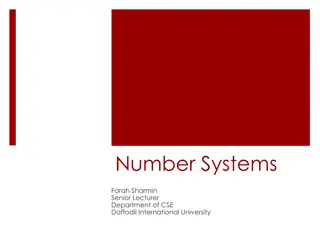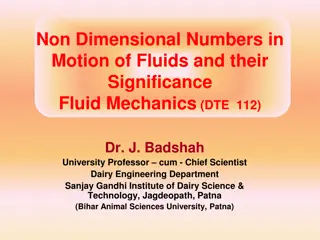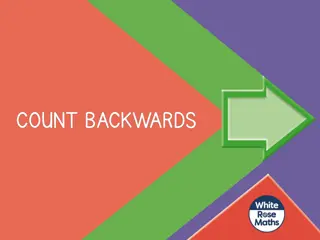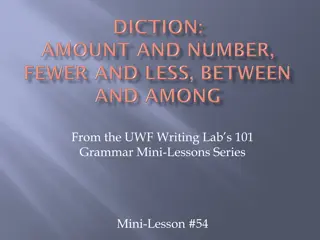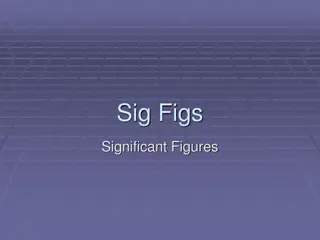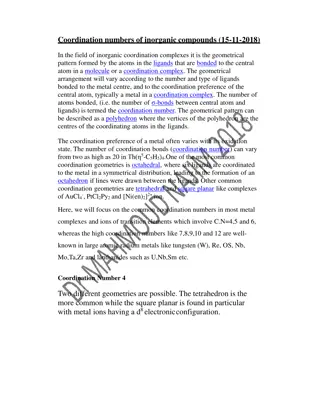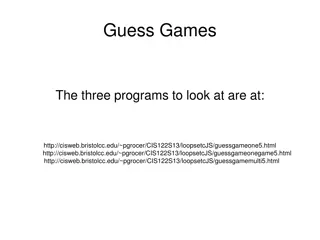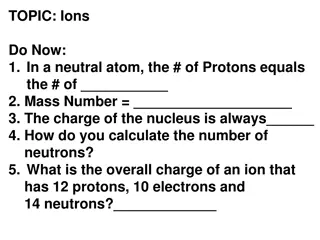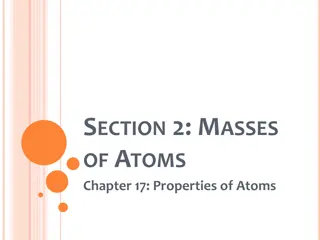
Understanding Number Systems and Binary Arithmetic
Explore the fundamentals of number systems, how numeric data is stored in computer memory, and learn about binary arithmetic operations like addition, multiplication, and division. Gain insights into the binary number system and its applications in computing.
Download Presentation

Please find below an Image/Link to download the presentation.
The content on the website is provided AS IS for your information and personal use only. It may not be sold, licensed, or shared on other websites without obtaining consent from the author. If you encounter any issues during the download, it is possible that the publisher has removed the file from their server.
You are allowed to download the files provided on this website for personal or commercial use, subject to the condition that they are used lawfully. All files are the property of their respective owners.
The content on the website is provided AS IS for your information and personal use only. It may not be sold, licensed, or shared on other websites without obtaining consent from the author.
E N D
Presentation Transcript
CS11001/CS11002 Programming and Data Structures (PDS) (Theory: 3-0-0) Class Teacher: Pralay Mitra Department of Computer Science and Engineering Indian Institute of Technology Kharagpur
Number System Number Representation
Topics to be Discussed How are numeric data items actually stored in computer memory? How much space (memory locations) is allocated for each type of data? int, float, char, etc. How are characters and strings stored in memory?
Number System :: The Basics We are accustomed to using the so-called decimal number system. Ten digits :: 0,1,2,3,4,5,6,7,8,9 Every digit position has a weight which is a power of 10. Base or radix is 10. Example: 234 = 2 x 102 + 3 x 101 + 4 x 100 250.67 = 2 x 102 + 5 x 101 + 0 x 100 + 6 x 10-1 + 7 x 10-2
Binary Number System Two digits: 0 and 1. Every digit position has a weight which is a power of 2. Base or radix is 2. Example: 110 = 1 x 22 + 1 x 21 + 0 x 20 101.01 = 1 x 22 + 0 x 21 + 1 x 20 + 0 x 2-1 + 1 x 2-2
Counting with Binary Numbers 0 1 10 11 100 101 110 111 1000 .
Multiplication and Division with base Multiplication with 10 (decimal system) 435 x 10 = 4350 Left Shift and add zero at right end Multiplication with 10 (=2 ) (binary system) 1101 x 10 = 11010 Right shift and drop right most digit or shift after decimal point Division by 10 (decimal system) 435 / 10 = 43.5 Division by 10 (=2) (binary system) 1101 / 10 = 110.1
Adding two bits Carries 0 + 0 = 0 0 + 1 = 1 1 + 0 = 1 1 + 1 = 10 1 1 1 1 1 1 1 0 1 0 0 1 1 0 + 1 0 1 carry
Binary addition: Another example The initial carry in is implicitly 0 1 1 1 1 1 1 0 1 1 0 0 0 0 0 1 0 1 (Carries) + (Sum) most significant bit (MSB) least significant bit (LSB)
Binary-to-Decimal Conversion Each digit position of a binary number has a weight. Some power of 2. A binary number: B = bn-1 bn-2 ..b1 b0 . b-1 b-2 .. b-m Corresponding value in decimal: D = bi 2i i = -m n-1
Examples 101011 1x25 + 0x24 + 1x23 + 0x22 + 1x21 + 1x20 = 43 (101011)2 = (43)10 1. .0101 0x2-1 + 1x2-2 + 0x2-3 + 1x2-4 = .3125 (.0101)2 = (.3125)10 2. 101.11 1x22 + 0x21 + 1x20 + 1x2-1 + 1x2-2 5.75 (101.11)2 = (5.75)10 3.
Decimal-to-Binary Conversion Consider the integer and fractional parts separately. For the integer part, Repeatedly divide the given number by 2, and go on accumulating the remainders, until the number becomes zero. Arrange the remainders in reverse order. For the fractional part, Repeatedly multiply the given fraction by 2. Accumulate the integer part (0 or 1). If the integer part is 1, chop it off. Arrange the integer parts in the order they are obtained.
Example 1 :: 239 2 2 119 --- 1 2 59 --- 1 2 29 --- 1 2 14 --- 1 2 7 --- 0 2 3 --- 1 2 1 --- 1 2 0 --- 1 239 (239)10 = (11101111)2
Example 2 :: 64 64 2 2 32 --- 0 2 16 --- 0 2 8 --- 0 2 4 --- 0 2 2 --- 0 2 1 --- 0 2 0 --- 1 (64)10 = (1000000)2
Example 3 :: .634 .634 x 2 = 1.268 .268 x 2 = 0.536 .536 x 2 = 1.072 .072 x 2 = 0.144 .144 x 2 = 0.288 : : (.634)10= (.10100 )2
Example 4 :: 37.0625 (37)10 = (100101)2 (.0625)10 = (.0001)2 (37.0625)10 = (100101 . 0001)2
Hexadecimal Number System A compact way of representing binary numbers. 16 different symbols (radix = 16). 0 0000 1 0001 2 0010 3 0011 4 0100 5 0101 6 0110 7 0111 8 1000 9 1001 A 1010 B 1011 C 1100 D 1101 E 1110 F 1111
Binary-to-Hexadecimal Conversion For the integer part, Scan the binary number from right to left. Translate each group of four bits into the corresponding hexadecimal digit. Add leading zeros if necessary. For the fractional part, Scan the binary number from left to right. Translate each group of four bits into the corresponding hexadecimal digit. Add trailing zeros if necessary.
Example 1. (1011 0100 0011)2 = (B43)16 2. (10 1010 0001)2 = (2A1)16 3. (.1000 010)2 = (.84)16 4. (101 . 0101 111)2 = (5.5E)16
Hexadecimal-to-Binary Conversion Translate every hexadecimal digit into its 4- bit binary equivalent. Examples: (3A5)16 = (0011 1010 0101)2 (12.3D)16 = (0001 0010 . 0011 1101)2 (1.8)16 = (0001 . 1000)2
Unsigned Binary Numbers An n-bit binary number B = bn-1bn-2 . b2b1b0 2n distinct combinations are possible, 0 to 2n-1. For example, for n = 3, there are 8 distinct combinations. 000, 001, 010, 011, 100, 101, 110, 111 Range of numbers that can be represented n=8 0 to 28-1 (255) n=16 0 to 216-1 (65535) n=32 0 to 232-1 (4294967295)
Signed Integer Representation Many of the numerical data items that are used in a program are signed (positive or negative). Question:: How to represent sign? Three possible approaches: Sign-magnitude representation One s complement representation Two s complement representation
Sign-magnitude Representation For an n-bit number representation The most significant bit (MSB) indicates sign 0 positive 1 negative The remaining n-1 bits represent magnitude. bn-1 bn-2 b1 b0 Sign Magnitude
Representation and ZERO Range of numbers that can be represented: Maximum :: + (2n-1 1) Minimum :: (2n-1 1) A problem: Two different representations of zero. +0 0 000 .0 -0 1 000 .0
Ones Complement Representation Basic idea: Positive numbers are represented exactly as in sign- magnitude form. Negative numbers are represented in 1 s complement form. How to compute the 1 s complement of a number? Complement every bit of the number (1 0 and 0 1). MSB will indicate the sign of the number. 0 positive 1 negative
Example :: n=4 0000 +0 0001 +1 0010 +2 0011 +3 0100 +4 0101 +5 0110 +6 0111 +7 1000 -7 1001 -6 1010 -5 1011 -4 1100 -3 1101 -2 1110 -1 1111 -0 To find the representation of -4, first note that +4 = 0100 -4 = 1 s complement of 0100 = 1011
Ones Complement Representation Range of numbers that can be represented: Maximum :: + (2n-1 1) Minimum :: (2n-1 1) A problem: Two different representations of zero. +0 0 000 .0 -0 1 111 .1 Advantage of 1 s complement representation Subtraction can be done using addition. Leads to substantial saving in circuitry.
Twos Complement Representation Basic idea: Positive numbers are represented exactly as in sign- magnitude form. Negative numbers are represented in 2 s complement form. How to compute the 2 s complement of a number? Complement every bit of the number (1 0 and 0 1), and then add oneto the resulting number. MSB will indicate the sign of the number. 0 positive 1 negative
Example :: n=4 0000 +0 0001 +1 0010 +2 0011 +3 0100 +4 0101 +5 0110 +6 0111 +7 1000 -8 1001 -7 1010 -6 1011 -5 1100 -4 1101 -3 1110 -2 1111 -1 To find the representation of, say, -4, first note that +4 = 0100 -4 = 2 s complement of 0100 = 1011+1 = 1100
Storage and number system in Programming In C short int 16 bits + (215-1) to -215 int 32 bits + (231-1) to -231 long int 64 bits + (263-1) to -263
Storage and number system in Programming Range of numbers that can be represented: Maximum :: + (2n-1 1) Minimum :: 2n-1 Advantage: Unique representation of zero. Subtraction can be done using addition. Leads to substantial saving in circuitry. Almost all computers today use the 2 s complement representation for storing negative numbers.
Subtraction Using Addition :: 1s Complement How to compute A B ? Compute the 1 s complement of B (say, B1). Compute R = A + B1 If the carry obtained after addition is 1 Add the carry back to R (called end-around carry). That is, R = R + 1. The result is a positive number. Else The result is negative, and is in 1 s complement form.
Example 1 :: 6 2 A = 6 (0110) B = 2 (0010) 6 2 = A - B 1 s complement of 2 = 1101 6 :: 0110 -2 :: 1101 1 0011 1 0100 +4 A Assume 4-bit representations. B1 R Since there is a carry, it is added back to the result. End-around carry The result is positive.
Example 2 :: 3 5 1 s complement of 5 = 1010 A 3 :: 0011 -5 :: 1010 1101 B1 R Assume 4-bit representations. Since there is no carry, the result is negative. -2 1101 is the 1 s complement of 0010, that is, it represents 2.
Subtraction Using Addition :: 2s Complement How to compute A B ? Compute the 2 s complement of B (say, B2). Compute R = A + B2 Ignore carry if it is there. The result is in 2 s complement form.
Example 1 :: 6 2 2 s complement of 2 = 1101 + 1 = 1110 A 6 :: 0110 -2 :: 1110 1 0100 B2 R Ignore carry +4
Example 2 :: 3 5 2 s complement of 5 = 1010 + 1 = 1011 A 3 :: 0011 -5 :: 1011 1110 B2 R -2
Example 3 :: -3 5 2 s complement of 3 = 1100 + 1 = 1101 2 s complement of 5 = 1010 + 1 = 1011 -3 :: 1101 -5 :: 1011 1 1000 Ignore carry -8
Floating-point Numbers The representations discussed so far applies only to integers. Cannot represent numbers with fractional parts. We can assume a decimal point before a 2 s complement number. In that case, pure fractions (without integer parts) can be represented. We can also assume the decimal point somewhere in between. This lacks flexibility. Very large and very small numbers cannot be represented.
Representation of Floating-Point Numbers A floating-point number F is represented by a doublet <M,E> : F = M x BE B exponent base (usually 2) M mantissa E exponent M is usually represented in 2 s complement form, with an implied decimal point before it. For example, In decimal, 0.235 x 106 In binary, 0.101011 x 20110
Example :: 32-bit representation M E 24 8 M represents a 2 s complement fraction 1 > M > -1 E represents the exponent (in 2 s complement form) 127 > E > -128 Points to note: The number of significant digits depends on the number of bits in M. 6 significant digits for 24-bit mantissa. The range of the number depends on the number of bits in E. 1038 to 10-38 for 8-bit exponent.
Floating point number: IEEE Standard 754 Storage Layout Sign Exponent Fraction / Mantissa Single Precision 1 [31] 8 [30 23] 23 [22 00] Double Precision 1 [63] 11 [62 52] 52 [51 00] Single: SEEEEEEE EMMMMMMM MMMMMMMM MMMMMMMM Double: SEEEEEEE EEEEMMMM MMMMMMMM MMMMMMMM MMMMMMMM MMMMMMMM MMMMMMMM MMMMMMMM
IEEE Standard 754 1. The sign bit is 0 for positive, 1 for negative. 2. The exponent base is two. 3. The exponent field contains 127 plus the true exponent for single-precision, or 1023 plus the true exponent for double precision. 4. The first bit of the mantissa is typically assumed to be 1.f, where f is the field of fraction bits. Ranges of Floating-Point Numbers Since every floating-point number has a corresponding, negated value (by toggling the sign bit), the ranges above are symmetric around zero.
IEEE Standard 754 Ranges of Floating-Point Numbers Since every floating-point number has a corresponding, negated value (by toggling the sign bit), the ranges above are symmetric around zero. Approximate Decimal 10 44.85 to 1038.53 10 323.3 to 10308.3 Denormalized Normalized 2 149 to (1 2 23) 2 126 2 1074 to (1 2 52) 2 1022 2 126 to (2 2 23) 2127 2 1022 to (2 2 52) 21023 Single Precision Double Precision
IEEE Standard 754 There are five distinct numerical ranges that single- precision floating-point numbers are not able to represent: Negative numbers less than (2 2 23) 2127 (negative overflow) Negative numbers greater than 2 149 (negative underflow) Zero Positive numbers less than 2 149 (positive underflow) Positive numbers greater than (2 2 23) 2127 (positive overflow) 1. 2. 3. 4. 5.
Special Values Zero 0 and +0 are distinct values Denormalized If the exponent is all 0s, but the fraction is non-zero, then the value is a denormalized number, which now has an assumed leading 0 before the binary point. Thus, this represents a number ( 1)s 0.f 2 126, where s is the sign bit and f is the fraction. For double precision, denormalized numbers are of the form ( 1)s 0.f 2 1022. From this you can interpret zero as a special type of denormalized number.
Special Values Infinity The values + and are denoted with an exponent of all 1s and a fraction of all 0s. The sign bit distinguishes between negative infinity and positive infinity. Being able to denote infinity as a specific value is useful because it allows operations to continue past overflow situations. Operations with infinite values are well defined in IEEE floating point. Not A Number The value NaN (Not a Number) is used to represent a value that does not represent a real number. NaN's are represented by a bit pattern with an exponent of all 1s and a non-zero fraction.
Representation of Characters Many applications have to deal with non-numerical data. Characters and strings. There must be a standard mechanism to represent alphanumeric and other characters in memory. Three standards in use: Extended Binary Coded Decimal Interchange Code (EBCDIC) Used in older IBM machines. American Standard Code for Information Interchange (ASCII) Most widely used today. UNICODE Used to represent all international characters. Used by Java.
ASCII Code Each individual character is numerically encoded into a unique 7-bit binary code. A total of 27 or 128 different characters. A character is normally encoded in a byte (8 bits), with the MSB not been used. The binary encoding of the characters follow a regular ordering. Digits are ordered consecutively in their proper numerical sequence (0 to 9). Letters (uppercase and lowercase) are arranged consecutively in their proper alphabetic order.
Some Common ASCII Codes A :: 41 (H) 65 (D) B :: 42 (H) 66 (D) .. Z :: 5A (H) 90 (D) 0 :: 30 (H) 48 (D) 1 :: 31 (H) 49 (D) .. 9 :: 39 (H) 57 (D) a :: 61 (H) 97 (D) b :: 62 (H) 98 (D) .. z :: 7A (H) 122 (D) ( :: 28 (H) 40 (D) + :: 2B (H) 43 (D) ? :: 3F (H) 63 (D) \n :: 0A (H) 10 (D) \0 :: 00 (H) 00 (D)







